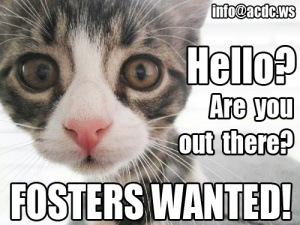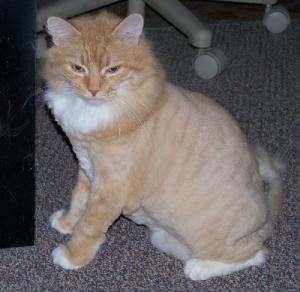 The Tidy Cat Whisperer has finally emerged from the pile of fan mail and is ready to deliver her next article. Well, let me clarify one thing: the Tidy Cat Whisperer (TCW-that’s me) doesn’t get any fan mail-all the nice, cutesy fan mail is for the Stinky Cat, who apparently is a celebrity in his own right. The only “fan” mail TCW gets is more like the mail Dear Abby gets (“TCW, help! My cat won’t stop peeing on the bed,” “Dear TCW-how can I tell if my adolescent cat is using drugs,” “TCW, help! My cat is a catnipaholic! Is there a 12-step program,” etc).
The Tidy Cat Whisperer has finally emerged from the pile of fan mail and is ready to deliver her next article. Well, let me clarify one thing: the Tidy Cat Whisperer (TCW-that’s me) doesn’t get any fan mail-all the nice, cutesy fan mail is for the Stinky Cat, who apparently is a celebrity in his own right. The only “fan” mail TCW gets is more like the mail Dear Abby gets (“TCW, help! My cat won’t stop peeing on the bed,” “Dear TCW-how can I tell if my adolescent cat is using drugs,” “TCW, help! My cat is a catnipaholic! Is there a 12-step program,” etc).
In general, most of the mail we get is regarding cats that are peeing outside the litter box. But lately all our mail has just turned to crap-literally. Cats having issues with Number Two is really a hot button all of a sudden. Now, as someone who grew up in a household with only one bathroom can tell you, the process of defecation is extremely important-for people and cats as we will see. A special shout out to all those fathers who on Sunday morning take the entire newspaper into the loo for an hour while the rest of us stand with our legs crossed and the matches ready. When I bought my first house the only requirement I had was that it have two bathrooms, I really didn’t care about anything else…..
There are several medical conditions that can cause your cat to have abnormal stools, or to begin defecating outside the box. Let’s briefly look at the most common-and hopefully everyone has finished their breakfast or dinner as this is NOT an article to read while eating!
Colitis is an inflammation of the colon, and can be a cause of “litterbox issues.” From the outside, it is impossible to tell if your cat has colitis as your cat will look perfectly normal to you. The giveaway is what they leave behind in the litter box. If their stool has frequent mucous and occasional flecks of blood, then it’s time for a trip to the vet. Also watch for vomiting. If you can, try and observe your cat when they are in the process of doing “number two.” Due to the inflammation in the colon, cats with colitis may have severe pain when defecating – they may actually try and stop the defecation process, which results in constipation. There may also be diarrhea-at any rate, none of this is a normal defecation process. Your vet will most likely want to examine the stool for any signs of intestinal parasites, and may also do a rectal exam and possibly a biopsy of the colon wall. Your vet will probably prescribe a bland diet to help the colon rest and heal, and it’s possible your cat will be eating a bland, easily digestible diet for life. Antibiotics may also be prescribed to help control bacterial causes, and other medications such as prednisone may be used.
Cats can also develop a condition called Inflammatory Bowel Disease (IBD), in which the intestine is consistently invaded by inflammatory cells. The most common symptoms of IBD are diarrhea, vomiting, and weight loss. According to Dr. Jennifer F. Johnson, VMD, the type of IBD is determined by what kind of inflammatory cells are invading the intestinal tract. The different types of IBD are: lymphocytic-plasmacytic, eosinophilic, or neutrophilic. Each type is characterized by the type of cells that become inflamed – kind of like the difference between VHS, Beta, DVD, and HD/DVD –they’re all in the same ballpark but sit in different rows. Cats can also develop IBD which is cancerous. This type of cancer of the intestines is usually classified as a Lymphoma. Lymphoma of the intestines will present with the same signs as a cat with non-cancerous IBD. The good news is that the majority of cats with IBD do not have cancer.
IBD is considered idiopathic in many cases (cause unknown). Some vets believe that IBD in cats is an autoimmune disorder. The only way to definitively diagnose IBD is by performing surgical biopsies of the intestines. Once the diagnosis is made, and the type of IBD is known, treatment can be started. IBD is generally a chronic condition which is not cured, but managed through diet and medication. Various types of diets generally are tried in order to rule out specific food intolerance.
I have fostered a few cats that had IBD and they generally seemed to do well on a limited ingredient diet. A limited ingredient diet is just what the name implies: the ingredients are limited to a specific few which have been proven to be tolerable to the cat’s digestive system. Studies have shown that some ingredients are more likely to cause issues than others. In cats, the most common offenders are beef, lamb, seafood, corn, soy, dairy products, and wheat gluten. In a limited ingredient diet, the protein is provided by a combination of green peas and either duck, rabbit, or venison, which are rarely associated with adverse food reactions in cats. Hill’s DD or ZD diets are veterinary prescription diets and are sold exclusively at your vet’s office, as are prescription diets by other manufacturers such as Royal Canin, Purina, and Iams. If your vet approves, you may also be able to manage your cat’s diet with Natural Balance Limited Ingredient Diets, which are not prescription, a bit less expensive, and can be purchased at local pet supply stores.
Another medical reason for your cat to avoid defecating in the litter box is anal gland disease. According to Dr. Johnson, all “predators,” be they the domestic ones like cats, dogs, or wild ones like the occasional skunk in your backyard, have anal glands-they just use them differently. (We all know how skunks uses theirs!) The glands have a secretion which cats and dogs use at times to mark their territory. Every time your cat makes a “doo-doo,” the surrounding muscles should put enough pressure on the anal glands so that they discharge some of this secretion.
However, the glands can become impacted, infected, and abscessed. Affected pets may lick the anal area, ‘scoot’ along the floor, or have problems with defecation. A trip to the vet is in order. The “easy” way out: the vet will have to manually “express” the glands, everyone holds their noses and then all is hunk-dory. The “hard” way out: if there is an abscess, it may need to be lanced. In severe cases, surgery may be required. If your cat has chronic impactions of the anal glands, your vet may suggest a high-fiber diet. The added fiber or bulk in the diet should put more pressure on the anal glands and hopefully result in a more normal stool with some anal expression. Sometimes your vet might also prescribe a food additive similar to a Metamucil or other fiber product to help “move things along.”
We know it’s a stinky job but for the good of your cat’s health it is always smart to occasionally observe your cat’s bathroom habits, and any unusual behavior or “output” should be noted and reported to your veterinarian. As always, Happy Scooping!
Acknowledgements to Dr. Jennifer F. Johnson, VMD, owner of Stoney Creek Veterinary Hospital for medical input, explanations and terms where noted.
 Pet-lovers often wonder what kind of people are able to foster pets who are waiting for permanent homes. The answer: people just like you.
Pet-lovers often wonder what kind of people are able to foster pets who are waiting for permanent homes. The answer: people just like you. one can be a good fosterer, what makes someone successful at it? On that, Stephanie, Laurie, and Kim all agree: a good foster parent is someone who cares about animals, wants to be involved with them, and is willing to be patient, responsible, and consistent as they work with their new pets.
one can be a good fosterer, what makes someone successful at it? On that, Stephanie, Laurie, and Kim all agree: a good foster parent is someone who cares about animals, wants to be involved with them, and is willing to be patient, responsible, and consistent as they work with their new pets.













